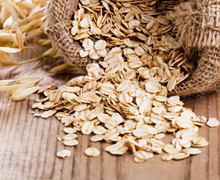
It’s not unusual for someone to see their waist size increase along with their blood pressure and blood sugar as they age, but new research shows whole grains can make a healthy difference. Middle-aged and older adults who ate at least three servings of whole grains daily experienced smaller increases in blood pressure, blood sugar and waist size over time than those who averaged less than one serving per day.
Researchers from Tufts University studied how whole grains impacted five risk factors for heart disease and published their findings in the Journal of Nutrition. They used data from the Framingham Heart Study Offspring Cohort and looked at waist size, blood pressure, blood sugar, triglyceride and HDL cholesterol.
The 3,100 people in the study were in their mid-50s when data collection started. Researchers wanted to better understand the health outcomes associated with whole- and refined-grain consumption and tracked the participants for a median time of 18 years.
The study participants were categorized by the amount of daily servings of whole grains. An example of a serving is a half cup of brown rice, a half cup of rolled oats or a slice of whole-grain bread. The five risk factors were measured over four-year intervals.
For each four-year time period the average waist-size increase for the lowest intake group was one inch, while it was only ½ inch among the high-intake group. Similar results were seen when it came to blood pressure and blood sugar levels even after accounting for the change in waist size.
"Our findings suggest that eating whole-grain foods as part of a healthy diet delivers health benefits beyond just helping us lose or maintain weight as we age,” said researcher Nicola McKeown. “In fact, these data suggest that people who eat more whole grains are better able to maintain their blood sugar and blood pressure over time. Managing these risk factors as we age may help to protect against heart disease."
The results were consisted throughout the study during each four-year interval.
"There are several reasons that whole grains may work to help people maintain waist size and reduce increases in the other risk factors,” said fellow researcher Caleigh Sawicki. “The presence of dietary fiber in whole grains can have a satiating effect, and the magnesium, potassium, and antioxidants may contribute to lowering blood pressure. Soluble fiber in particular may have a beneficial effect on post-meal blood sugar spikes."
The most common food items for that contributed to the whole-grain totals were whole-wheat bread and whole-grain breakfast cereal. The most common refined grains were pasta and white bread. Whole grains have a fiber-rich outer layer and inner germ layer with vitamins, antioxidants and some healthy fats. The milling process strips those beneficial nutrients and leaves the high-starch grain behind.
"The average American consumes about five servings of refined grains daily, much more than is recommended, so it's important to think about ways to replace refined grains with whole grains throughout your day," McKeown said. “For example, you might consider a bowl of whole-grain cereal instead of a white flour bagel for breakfast and replacing refined-grain snacks, entrees, and side dishes with whole-grain options. Small incremental changes in your diet to increase whole-grain intake will make a difference over time.”
